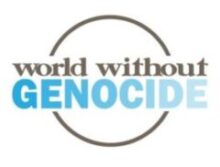On Indigenous Peoples Day, recalling forced sterilizations of Native American women
The second-class status of Native Americans reaches beyond the history of forced sterilizations. For decades, Native women have been sex-trafficked, abused, and disappeared at rates far higher than women of any other group in the United States.
By Ellen J. Kennedy
Oct. 14, 2019
When people hear the word “genocide” they often think of exterminations in gas chambers during the Holocaust or mass murder by machete in Rwanda. But the crime of genocide is defined as the intent to destroy, in whole or in part, a national, ethnic, racial, or religious group. The definition of “genocide” includes killing but it also includes less visible measures – such as preventing births within the group, which is a goal of forced sterilization.
One of the most widespread uses of forced sterilization occurred during the Nazi era. In 1933, the very first year that the Nazis were in power, they passed the Law for the Prevention of Genetically Defective Progeny. The law supported and encouraged compulsory sterilization of people with various physical and cognitive disabilities. This was part of the eugenics movement of the time, a pseudo-science with the vision of eliminating “negative family traits” through forced genetic engineering.
The Nazis’ sterilization law established a network of more than 200 “Hereditary Health Courts” consisting of a judge, a medical officer, and a medical practitioner. The courts were empowered to “decide at their own discretion after considering the results of the whole proceedings and the evidence tendered” who should be sterilized.
Under the courts’ rulings, 400,000 men and women were sterilized against their will using cruel procedures that had been tested on prisoners in the concentration camp system, especially on prisoners at Auschwitz and at Ravensbruck, the concentration camp for women.
Hitler didn’t come up with this concept to eliminate “defectives” to create a superior race. Well before the Nazi regime, the United States led the world in forced sterilizations. Hitler had learned about the U.S. practices, writing, “There is today one state in which at least weak beginnings toward a better conception [of citizenship] are noticeable. Of course, it is not our model German Republic, but the United States.”
1907 to 1939: 30,000+ people sterilized in U.S.
Between 1907 and 1939, more than 30,000 people in 29 U.S. states were sterilized, unknowingly or against their will, while they were incarcerated in prisons or in institutions for the mentally ill. Nearly half of the operations were carried out in California. Race and class figured prominently in the decisions by panels of doctors and public health practitioners as they targeted for forced sterilizations those who were poor, non-white, and who were perceived as “foreigners.”
These practices did not end in the mid-20th century. In fact, California prisons authorized sterilizations of nearly 150 female inmates between 2006 and 2010, driven in part by anti-Asian and anti-Mexican prejudice, in a practice that wasn’t outlawed until 2014. Southern states also employed sterilization as a means of controlling African-American populations by means of “Mississippi appendectomies,” the name for unnecessary hysterectomies performed on women of color as practice for medical students at Southern teaching hospitals. A third of the sterilizations were done on girls under age 18, some girls reportedly as young as 9 years old.
The U.S. Indian Health Service (IHS) later applied forced sterilization to American Indian women in the 1960s and 1970s, sterilizing 3,406 Native American women between 1973 and 1976. In 1976, the U.S. General Accounting Office admitted that this took place in at least four of the 12 Indian Health Service regions. The numbers include women in Minnesota as well as 36 women under age 21, despite a court-ordered moratorium on sterilizations of women younger than 21. Their study, however, was very limited and the actual numbers are likely considerably higher.
Two years earlier, in 1974, a study by Dr. Connie Pinkerton-Uri, a Chocktaw/Cherokee physician, found that at least one in four American Indian women had been sterilized without consent. Dr. Pinkerton-Uri concluded that the Indian Health Service appeared to have “singled out full-blooded Indian women for sterilization procedures.” Some experts estimate that the percent of American Indian women who were sterilized might even approach 50 percent. The targeted women were between ages 15 and 44.
Devastating impact on tribes
With a total Native American population of approximately 1 million in 1976, sterilization in many tribes had a devastating impact on a tribe’s survival. Pinkerton-Uri observed, “There are about only 100,000 [Native American] women of childbearing age left. A 200 million population could support voluntary sterilization and survive, but for Native Americans it cannot be a preferred method of birth control. Where other minorities might have a gene pool in Africa or Asia, Native Americans do not. When we are gone, that’s it.”
Why did this happen, and why did it happen to such an extent? The answer lies in a combination of economic, racial, and social factors.
As a result of the 1960s’ “war on poverty,” the number of people on welfare increased significantly in the 1960s and 1970s. According to a study by the Health Research Group in 1973 and additional interviews in the two subsequent years, most physicians performing the non-voluntary sterilizations were white males who believed that they were helping the country by limiting births in low-income minority families. The physicians assumed that they were enabling the government to cut funding for Medicaid and welfare programs while also reducing their own personal tax burden to support the federal programs.
Economic incentives
Physicians had additional economic incentives. They increased their own income by performing hysterectomies and tubal ligations (surgical sterilization procedures) instead of prescribing alternative inexpensive methods of birth control. Some of them also did not believe that American Indian and other minority women had the capability to use other means of birth control effectively.
The 1970s was also the time of the rise of social protest by African-American and Native American organizations such as the Black Panthers and the American Indian Movement (AIM). These groups were perceived by many whites as being militant, radical, and dangerous, and this, too, influenced the willingness to sterilize women of color.
Other doctors wanted to get experience in obstetrics and gynecology, and they used minority women as the means to get that experience at government expense.
Medical personnel also believed they were actually helping these women. Minority families would become more financially secure with fewer children while simultaneously lessening the welfare burden on others.
Obviously, the sterilization of Indian women affected their families and communities. Marriages dissolved and the women suffered higher rates of psychological problems, often including drug abuse, alcoholism, shame, and guilt.
Although Latina, African-American, and Native American women all suffered grievously, American Indian women were easier targets because of their greater social invisibility, smaller numbers, and laws that facilitated bureaucratic secrecy about the government’s sterilization policies. It took years of hearings, news reports, investigative analyses, and interviews with women to bring to light the scope of the individual, family, and tribal impact of forced sterilizations.
In September 1977, the National Council of Church’s Interreligious Foundation for Community Organization held a conference in Washington, D.C., to plan strategies for a “fight for survival” against sterilization abuse. More than 60 delegates from Native American, African-American, Hispanic, civil rights, religious, and other groups attended the conference. While the conference addressed the abuses that all minority groups faced, it focused on those that Native American and Hispanic women underwent.
1977 report: 24% of Native American women sterilized
In 1977 the United Nations released a report prepared in conjunction with the Native American Solidarity Committee. It outlined the genocidal practices of the U.S. government, including the sterilization of Native American women. The report concluded that 24 percent of Native women had been sterilized and that 19 percent of the women were of child-bearing age.
The second-class status of American Indians reaches beyond the history of forced sterilizations in the 1970s to today. For decades, American Indian women have been sex-trafficked, abused, and disappeared at rates far higher than women of any other group in the United States. Because brave women — and men — have come forward to raise awareness of these crimes of opportunity and impunity, legislatures in several states, including Minnesota, have recently created task forces to study the high numbers of missing and murdered indigenous women and to implement strategies to end these abuses. We look forward to the Minnesota task force report.
In addition, there is a movement to designate the second Monday of every October as Indigenous Peoples Day in cities and states across the U.S. to honor and celebrate the culture and heritage of Native American and other indigenous peoples. In some places this designation replaces Columbus Day, while in other locations the day is given both labels. Minnesota has not joined the many states that have permanently legislated Indigenous Peoples Day, although there have been some annual state resolutions. Several Minnesota cities, including Minneapolis and St. Paul, recognize Indigenous Peoples Day, but some cities, such as Edina, have rejected the proposal.
I urge state and city support for the designation of Indigenous Peoples Day to honor our indigenous communities and to stand together to address current challenges.
 Ellen J. Kennedy, Ph.D., is the executive director of World Without Genocide at Mitchell Hamline School of Law.
Ellen J. Kennedy, Ph.D., is the executive director of World Without Genocide at Mitchell Hamline School of Law.


